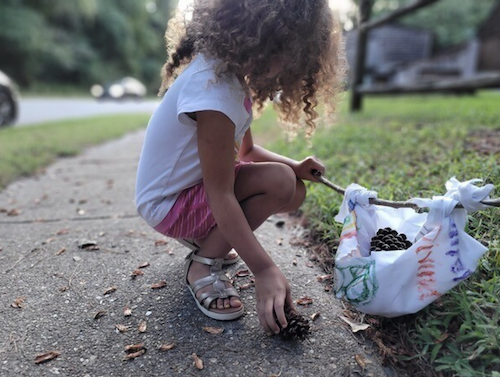Pack a Pretend Campsite
-
Age: 0 to 8+
-
Time: 1 hour+
-
Materials: Sticks and nature treasures; bin or box; pillowcases or fabric; crayon or markers; printable packing list
- Skills: Communication, Creativity, Behavioral Schema
This week at Tinkergarten Anywhere kicks off our final unit and is the first of three lessons to prepare for our final Camp Out lesson—and the chance to camp in or out! Inspired by printed packing lists, we'll use "bindles" to gather and pack up the treasures we'll need for our pretend campsite cookout.
The Guide
Step 1: Gather materials:
- Sticks and nature treasures
- Bin or box
- Pillowcase or fabric
- Crayon or markers
- Printable packing list
Step 2: Watch the Tinkergarten Anywhere Pack For Camp video lesson.
Hop into your My Tinkergarten trial dashboard to watch the Pack For Camp video lesson. Kids can watch how Meghan and other explorers collect materials for their campsite cookout, then get inspired to pack for their own camp out!
Not yet enrolled in Tinkergarten Anywhere? Join now or try a free trial here.
Not yet enrolled in Tinkergarten Anywhere? Join now or try a free trial here.
Step 3: Invite play and make a list.
After you watch the video, ask kids, “How can you gather the things you need for a pretend campsite cookout?”
Generate some ideas together. What could you find in your outdoor space to build a pretend campfire? To make pretend food? Offer kids a piece of paper and marker and invite them to draw or write some ideas. Or, print out our Campsite Cookout Packing List, look over the ideas together and add some more of your own.
Step 4: Make a bindle.
Show kids your box or bin and agree that this could be a treasure box to hold all of the materials you gather from your list. Ask, “Should we make a bindle, a special tool to help us gather all of the materials?”
To make a bindle:
- You'll need one piece of fabric or an old pillowcase (if using a pillowcase, you’ll need to cut it in half and use the half with the pouch).
- (optional) Decorate the bindles: We've had good luck with using fabric markers, dot paints and dry erase crayons.
- Find a stick: Guide kids to find a stick long enough to go from their hands and about a foot over their shoulders.
- Tie on the sack: Tie the bindle sack to one end of a stick making two knots on either side of the fabric.
Step 5: Collect treasures.
Make sure kids understand how to slip an object into the bindle. Then, let kids start exploring, gathering treasure, and carting goodies about. When the bindle becomes full or heavy, dump the contents into the treasure box, then head out to collect some more. As kids gather items from their packing list, invite them to check them off the list.
Want more ideas?
- Decorate your Treasure Box! Find ideas in the Nature Treasure Box DIY Activity.
- Sort and organize your treasures by size, color, weight, texture or any other category kids come up with.
- Make more lists! Find ways to involve kids in everyday communication practices. This week, try to invite your explorer to help you create a grocery shopping list, make a chart of chores or a schedule of what they would like to do and play.
Why is this activity great for kids?
We use and practice our communication skills every day in our daily routines and practices. Making and following a packing list is a great way to help kids collect, organize and share their ideas. This activity also supports two of the universal behavior patterns recognized to help both brain and body develop through play. Filling up the sack and carting things around supports the transporting schema, while tucking objects into a sack also exercises the enveloping schema. Searching and selecting treasures to put in their bindles helps kids develop their focus and observation skills. Noticing and engaging with nature treasures activates the senses.





